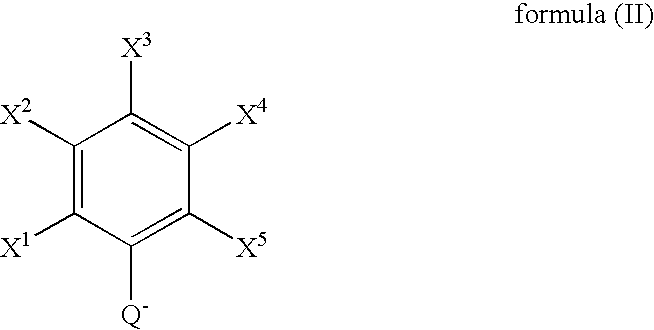Preparation of new radiation-curing binders
a technology of binding binders and radiation cure, which is applied in the direction of coatings, polyurea/polyurethane coatings, etc., can solve the problems of high reaction temperature requirements for this purpose (120°
- Summary
- Abstract
- Description
- Claims
- Application Information
AI Technical Summary
Benefits of technology
Problems solved by technology
Method used
Image
Examples
example 1
Tetrabutylammonium Salicylate
[0144]A glass flask with reflux condenser, heatable oil bath, mechanical stirrer and internal thermometer was charged at room temperature with 35.90 g of ethyl salicylate and 282.13 g of water and these components were stirred together thoroughly. Subsequently 139.98 g of tetrabutylammonium hydroxide (40% strength in water) were added and the reaction mixture was heated to 60° C. It was stirred at 60° C. for one hour (the contents of the flask become clear). Then the reaction mixture was cooled and the water was distilled off under reduced pressure, 20 mbar, at 30-45° C. The residue was taken up at 60° C. in 200 ml of toluene. Subsequently the mixture was redistilled. The residue was recrystallized from 50 ml of butyl acetate. The product was filtered off, washed with butyl acetate and dried at 80° C. and 10 mbar in a vacuum drying cabinet. This gave a white solid having a melting point of 93° C.
example 2
Inventive Allophanate-Containing Binder
[0145]A three-necked flask with reflux condenser, stirrer and dropping funnel, and through which air was passed (6 l / h), was charged at RT with 47.02 g of Desmodur® N3400, 0.10 g of 2,6-di-tert-butyl-4-methylphenol and 0.001 g of Desmorapid® Z and this initial charge was then heated to 60° C. 28.00 g of 2-hydroxyethyl acrylate was slowly added dropwise, in the course of which a maximum temperature of 70° C. was attained. Thereafter the reaction mixture was held at 70° C. until the NCO content −1 after 5.5 h only a very weak signal for uretdione groups was detectable. The product obtained was clear and had a viscosity of 8700 mPas / 23° C. with a solids content of 81.8% and an NCO content of 0%.
[0146]Examples 3-6 were conducted in analogy to Example 2. The amounts used, in [g], were those listed in the table below.
[0147]
Example23456Desmodur ® N340047.0245.9343.8941.7820.122-hydroxyethyl acrylate28.0027.3526.1424.8811.45Butyl acetate20.0020.0020.00...
PUM
| Property | Measurement | Unit |
|---|---|---|
| temperatures | aaaaa | aaaaa |
| temperatures | aaaaa | aaaaa |
| temperatures | aaaaa | aaaaa |
Abstract
Description
Claims
Application Information
 Login to View More
Login to View More - R&D
- Intellectual Property
- Life Sciences
- Materials
- Tech Scout
- Unparalleled Data Quality
- Higher Quality Content
- 60% Fewer Hallucinations
Browse by: Latest US Patents, China's latest patents, Technical Efficacy Thesaurus, Application Domain, Technology Topic, Popular Technical Reports.
© 2025 PatSnap. All rights reserved.Legal|Privacy policy|Modern Slavery Act Transparency Statement|Sitemap|About US| Contact US: help@patsnap.com


